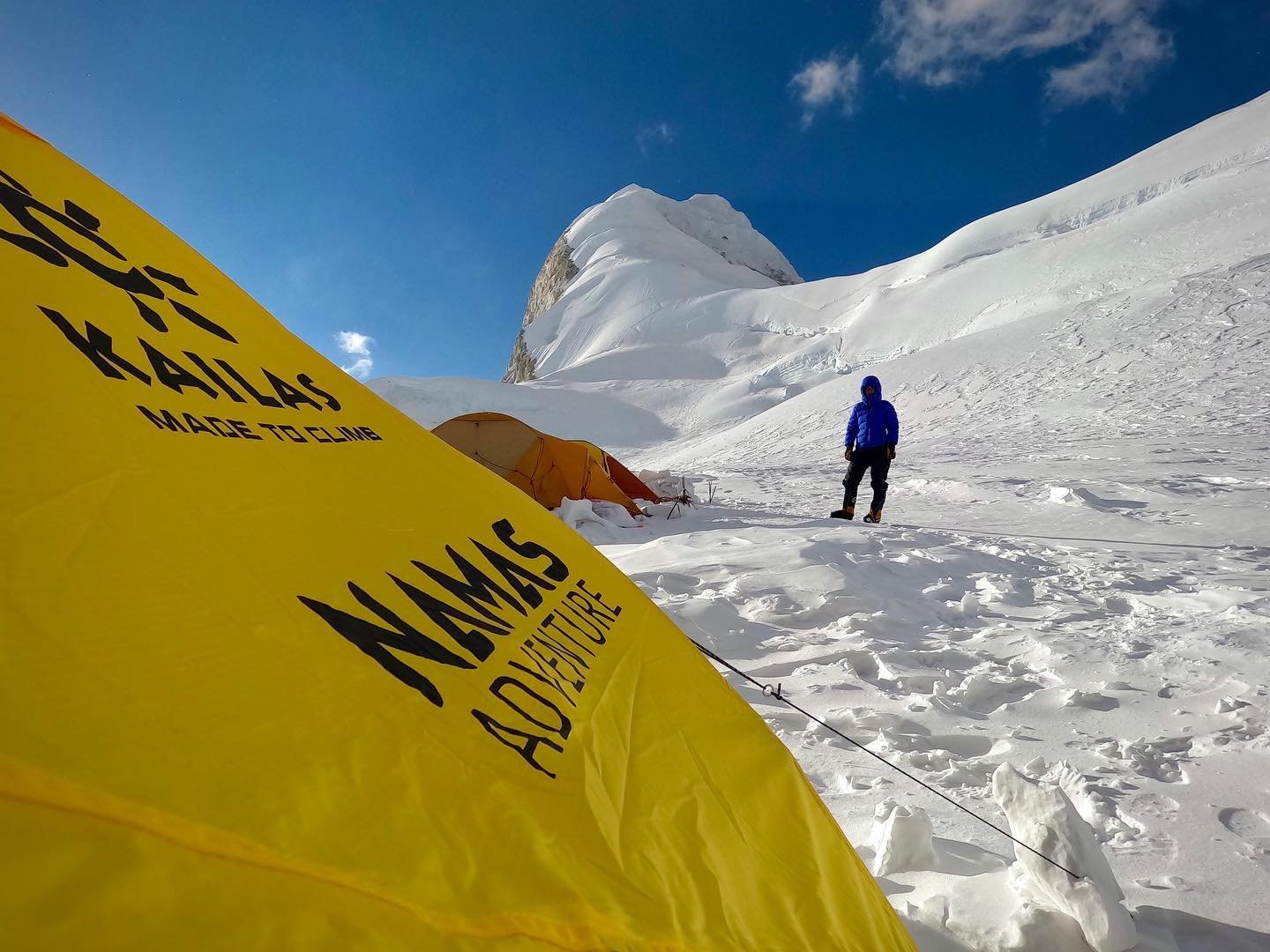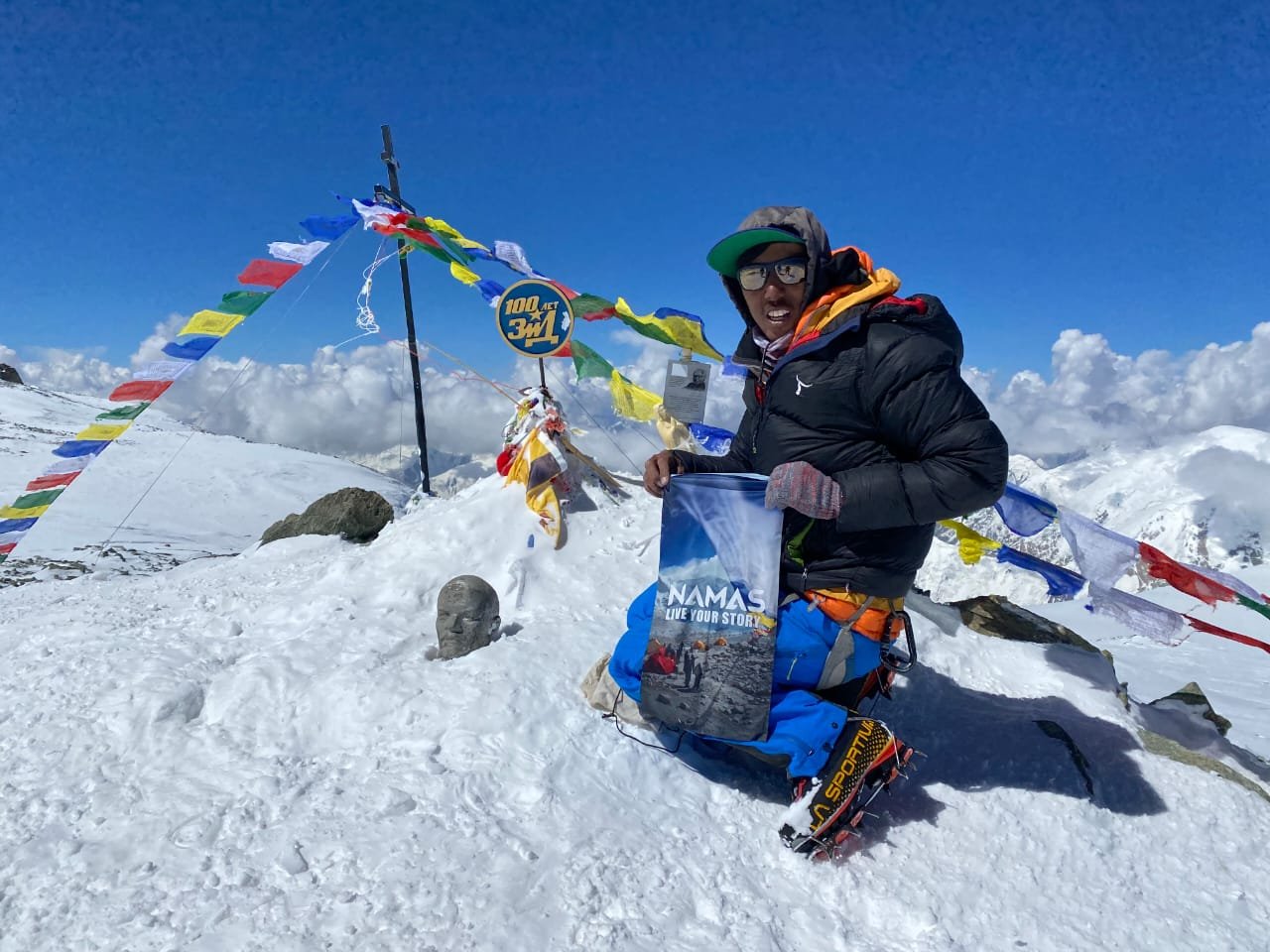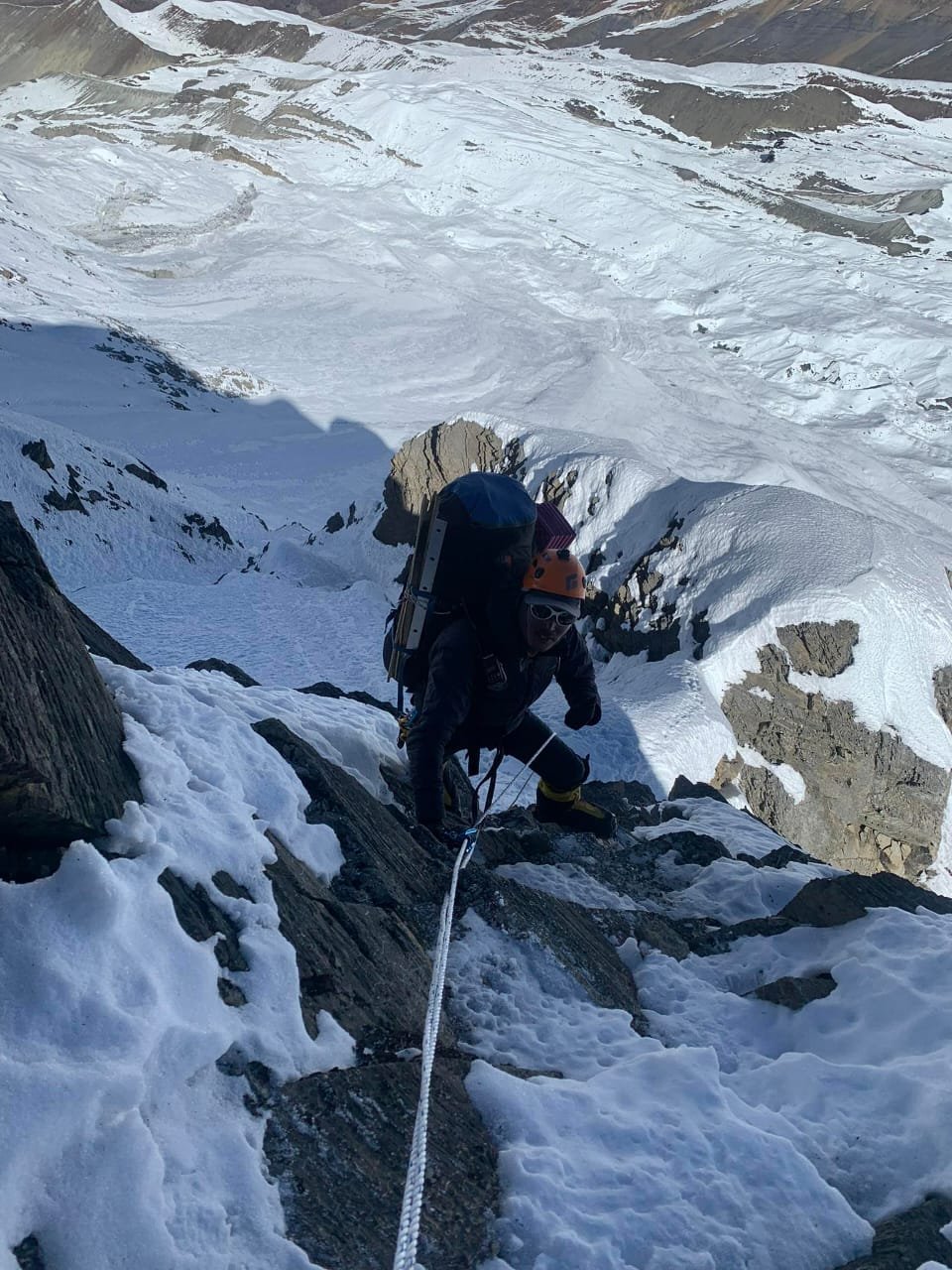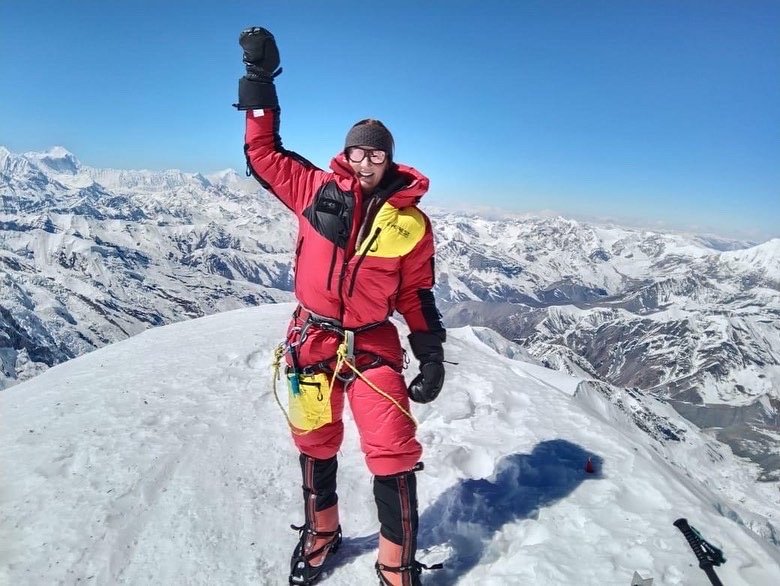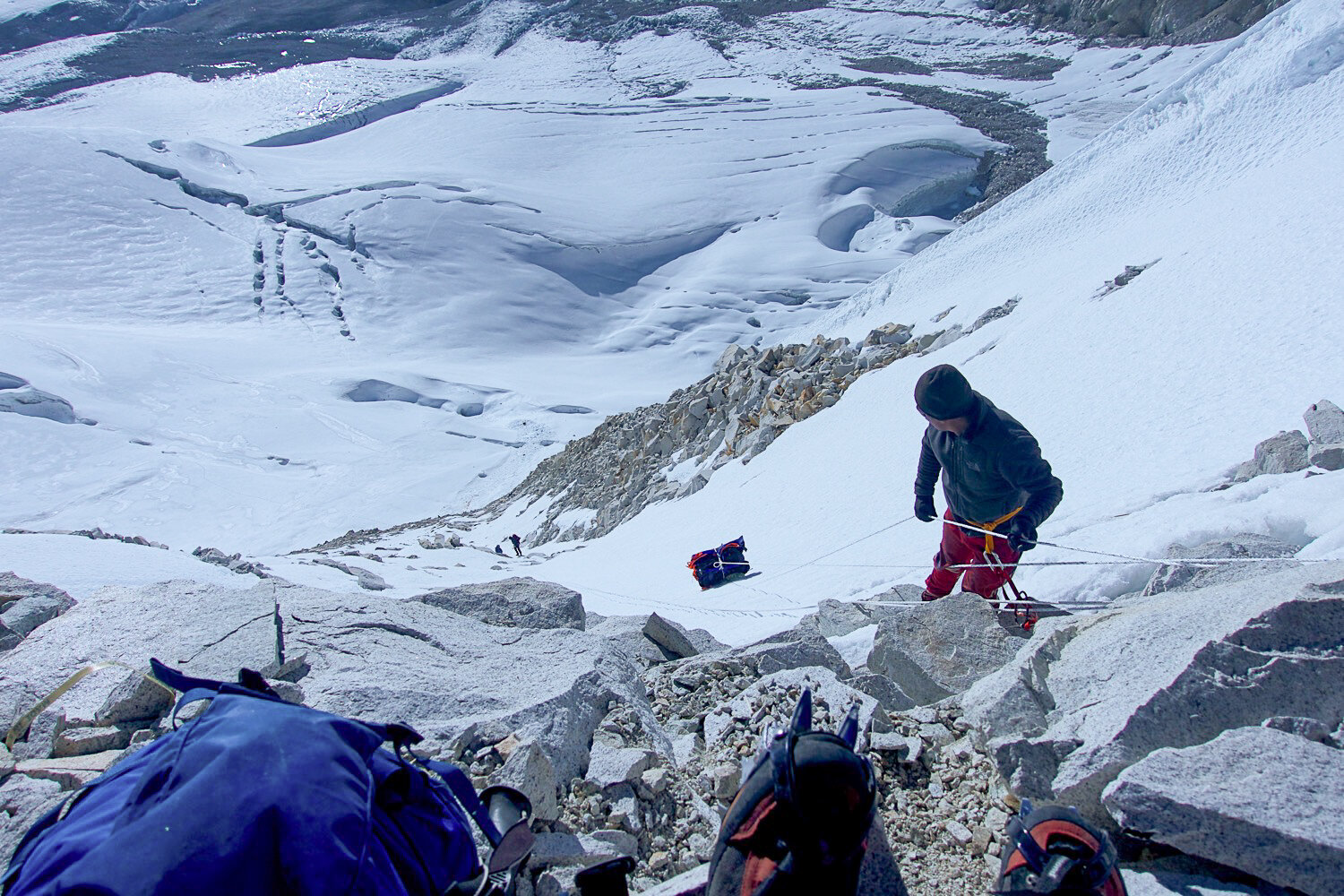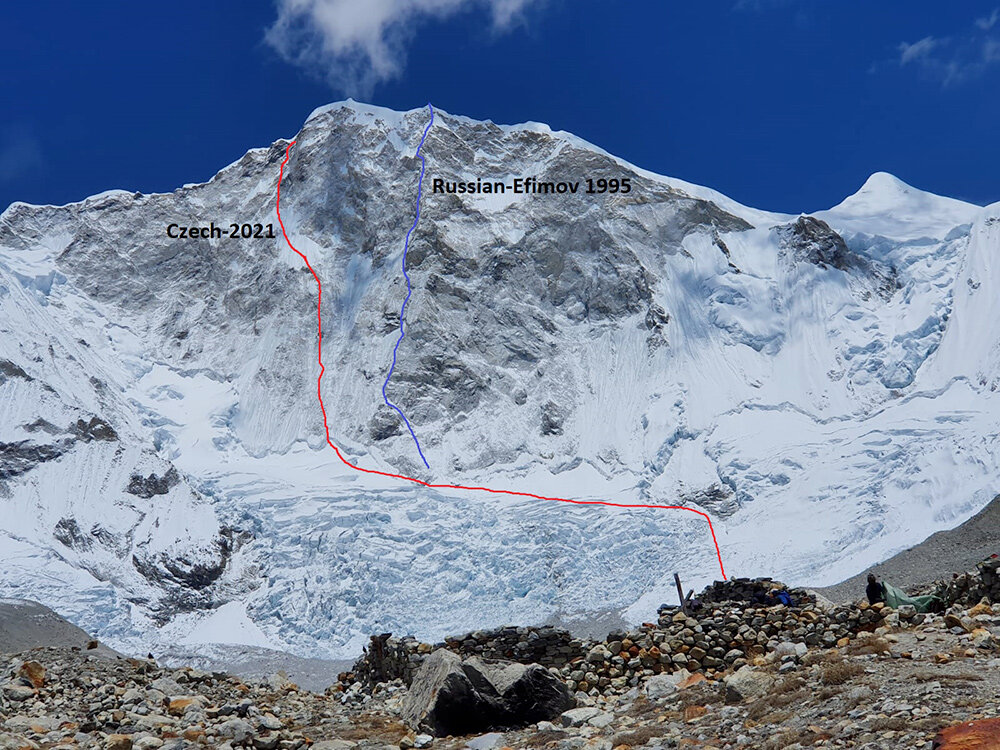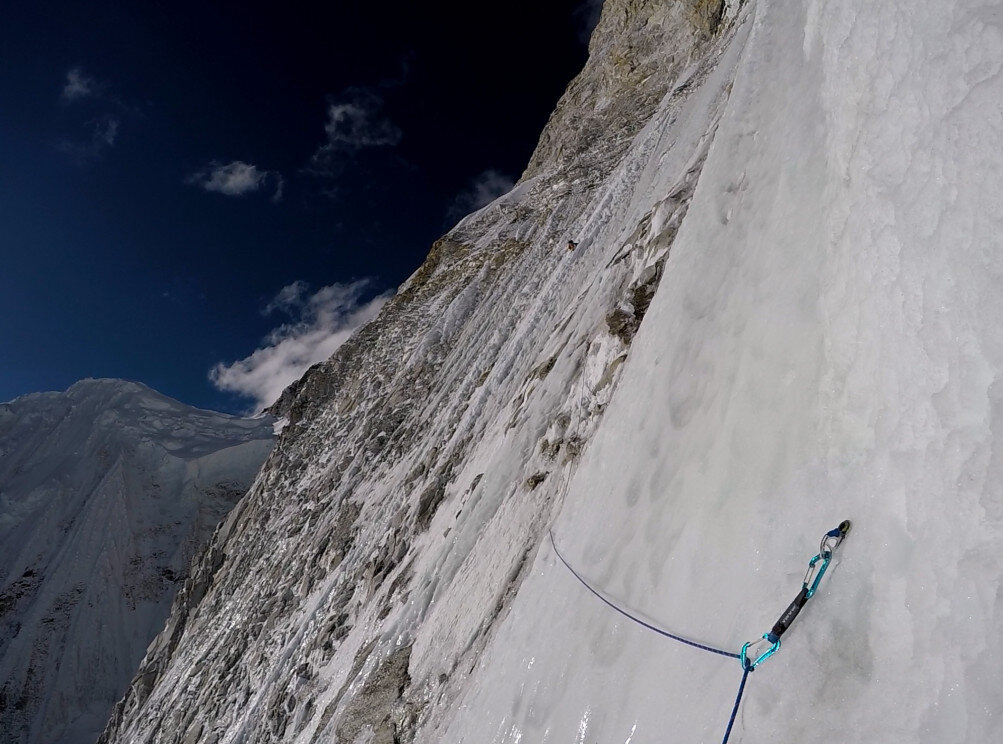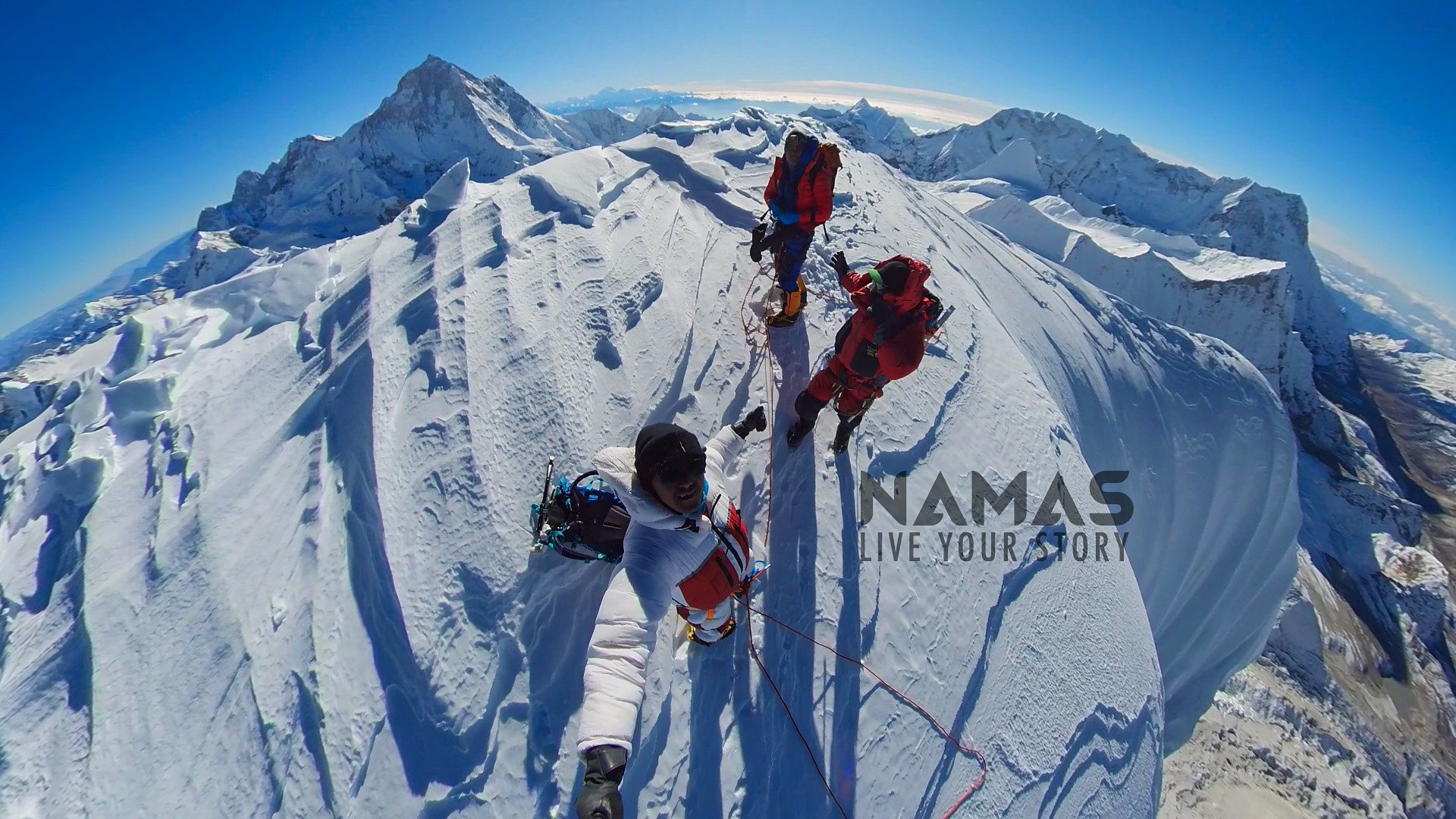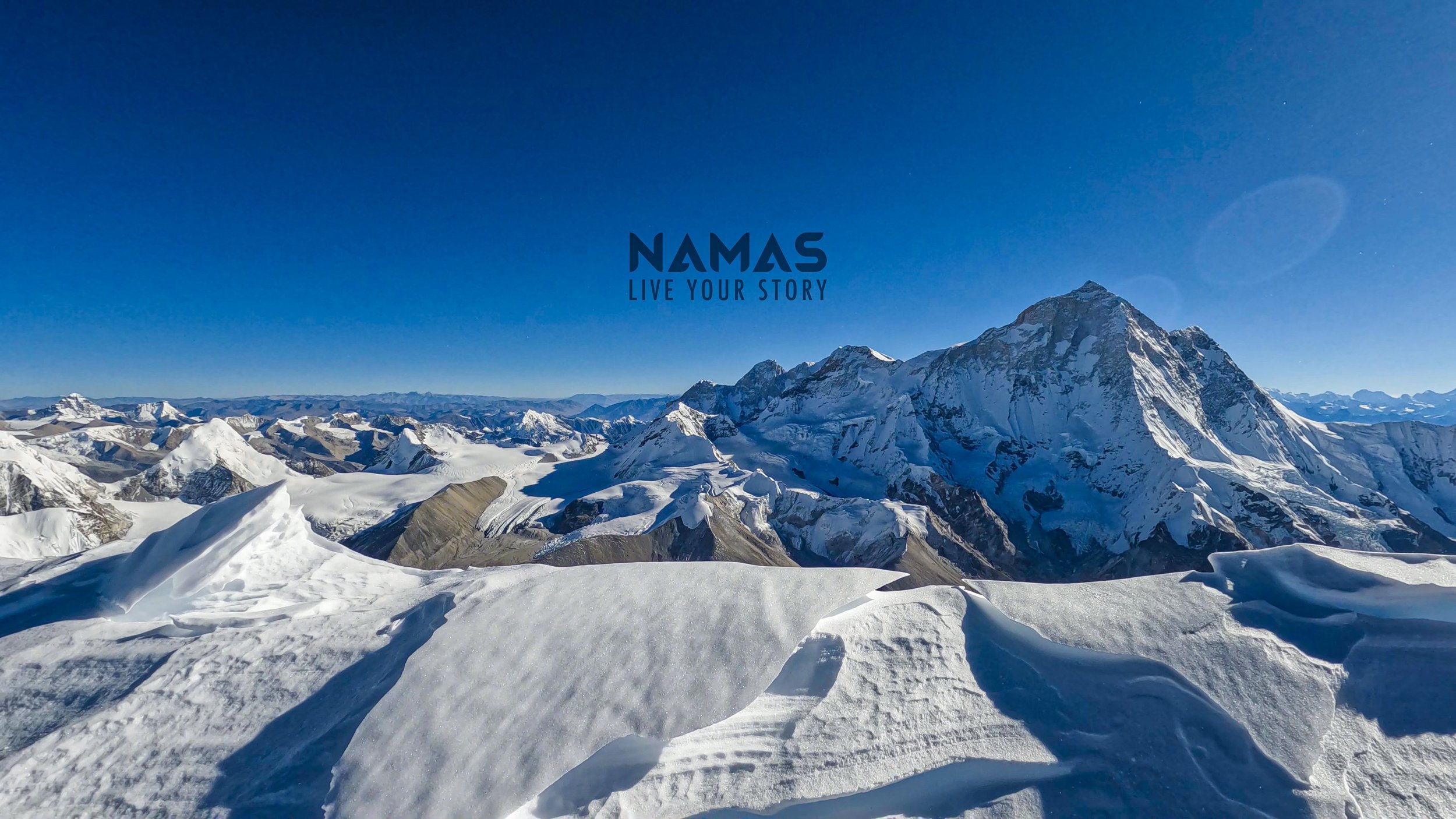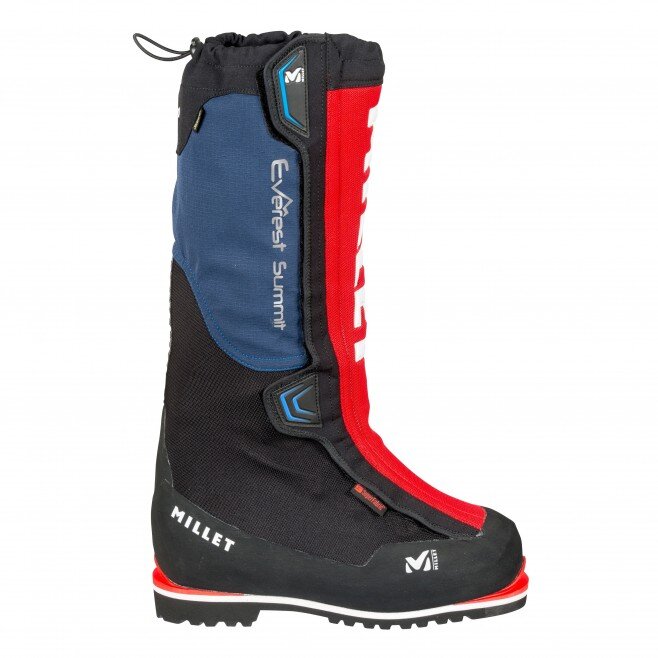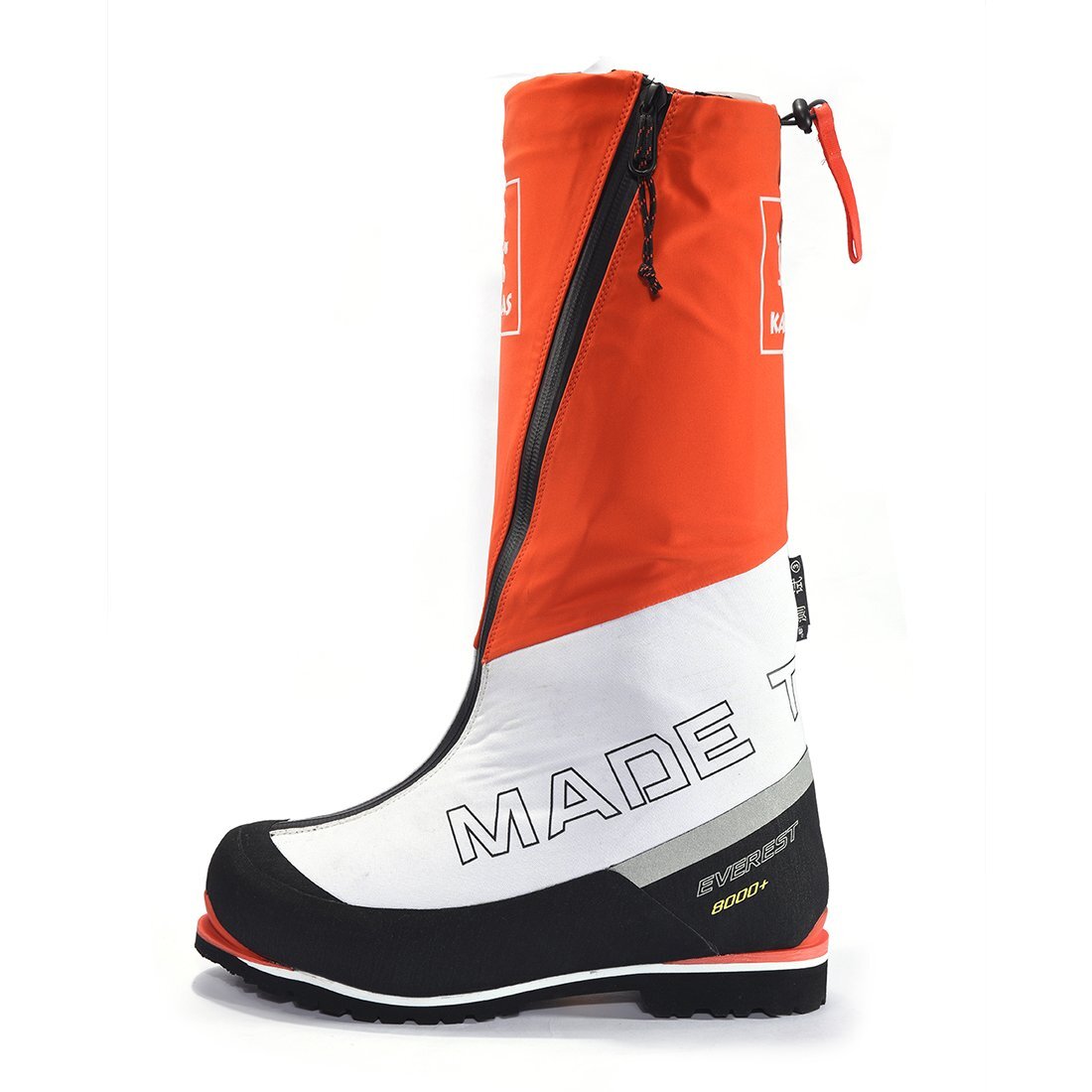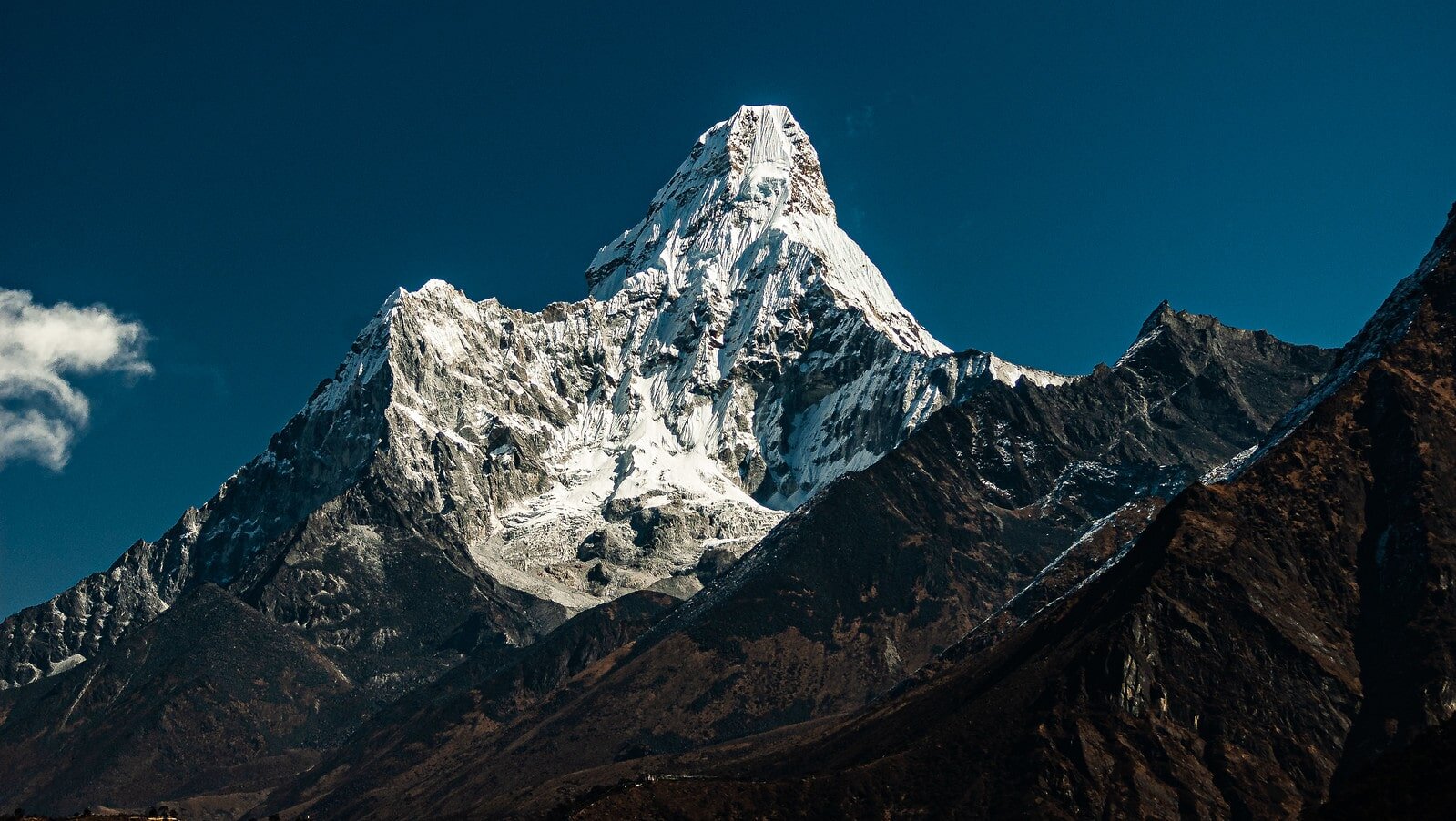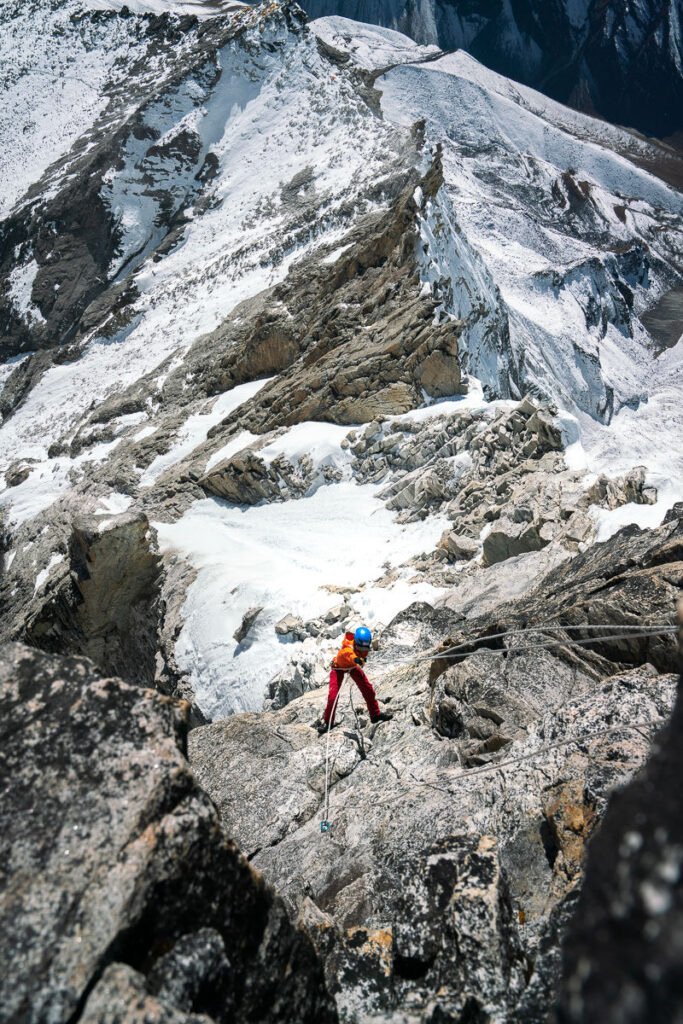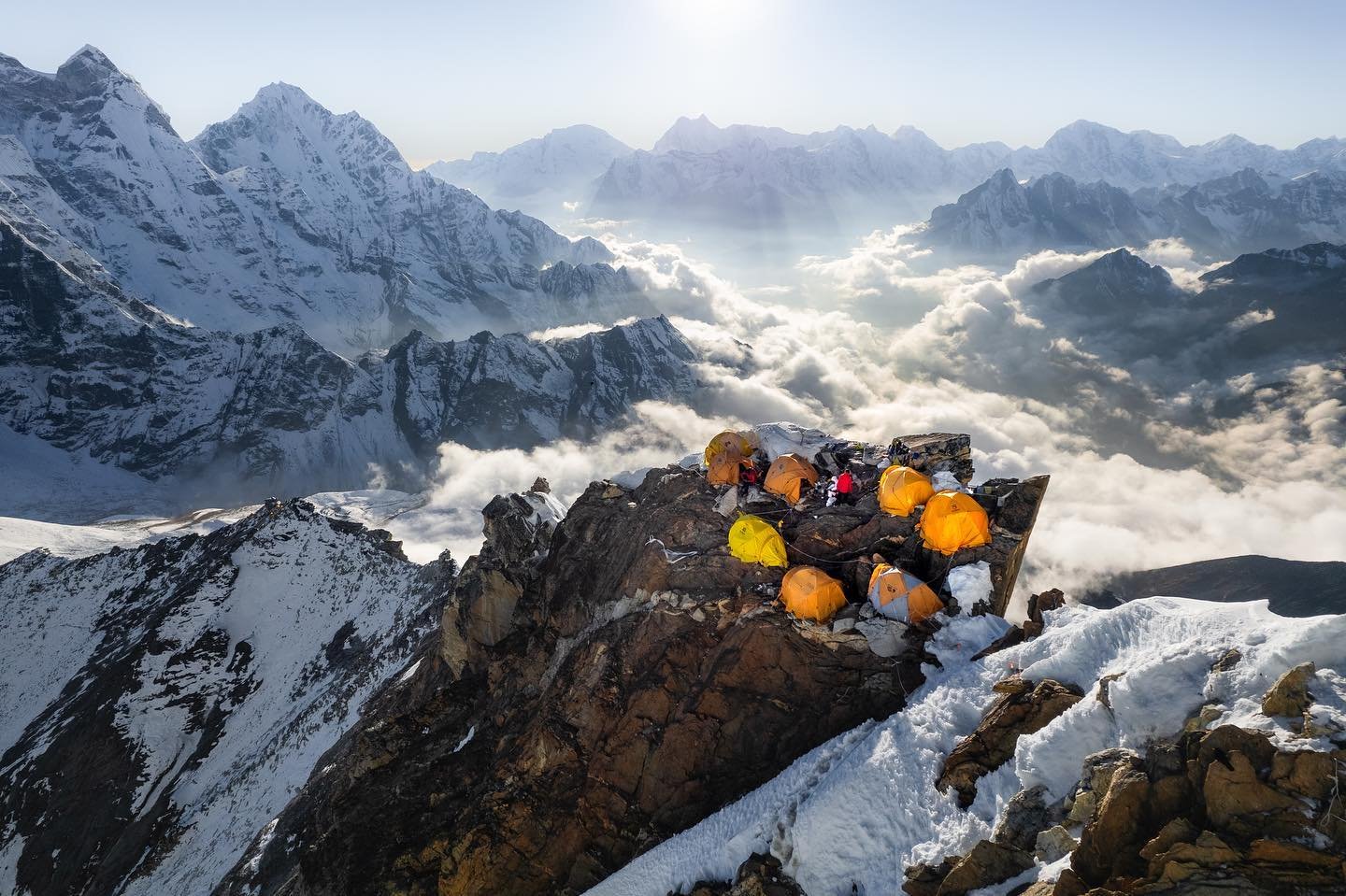A Guide to Climbing at-least one 8000M+ Mountain peak
How can I prepare to climb an 8000m peak? I aspire to summit at least one 8000m peak. What steps should I take to fulfill this dream of mine? These are common inquiries we receive from passionate adventurers seeking guidance on their journey to conquer the world's highest peaks.
Is it your dream to climb at least one 8000M+ in your lifetime? If so, then in this blog article we aim to guide you towards how to prepare for an 8000M+ climb through preparatory stages, and which 8000m peak should undoubtedly be on your initial list.
Embarking on the journey to summit an 8000m peak is a dream cherished by many adventurers. In this comprehensive guide, we provide expert advice to prepare you for this monumental endeavor and recommend the ideal peaks to start your journey. Pushing your limits and summiting one of the 8000M peaks on Earth can be an incredibly rewarding and life-changing experience.
Setting Your Goals High: Summiting an 8000m peak epitomizes the ultimate test of endurance, skill, and mental resilience. Few achievements rival the sense of accomplishment gained from conquering these towering giants. By setting your sights on an 8000m peak, you embark on an extraordinary adventure that promises unforgettable experiences and lifelong memories.
Preparation Is Key: Climbing an 8000m peak demands meticulous planning, rigorous training, and expert guidance. Before undertaking such a formidable challenge, it is imperative to undergo comprehensive mountaineering training and seek guidance from seasoned professionals. Additionally, climbing several 4000m-6000m peaks is essential to hone your skills and build confidence for the ultimate ascent.
Gradual Progression: Success in mountaineering requires patience and gradual progression. Before attempting an 8000m expedition, it is advisable to summit at least one 7000m or 7500m peak to acclimatize to higher altitudes and assess your readiness. This incremental approach allows you to gain valuable experience and confidence before tackling the grandeur of an 8000m peak.
Endurance & Strength is Essential: Achieving success at high altitudes necessitates exceptional physical fitness and endurance. Incorporate regular endurance, muscular endurance, and strength training into your routine to build stamina and resilience. Activities such as hiking, running, cycling, and weight training are invaluable in preparing your body for the rigors of high-altitude climbing.
Mind Over Matter: Mental preparedness is just as crucial as physical strength in the realm of mountaineering. Cultivating a positive mindset, envisioning success, and mentally preparing for the trials ahead are paramount. Maintaining focus, determination, and resilience amidst adversity is key to overcoming obstacles and inching closer to your summit goal. While these may seem like clichés, they hold immense significance during the final stages of safely completing your ascent of an 8000m peak.
So, which 8000M+ should you climb? Below are our recommendations
Choosing Your Peak: For climbers with minimum prerequisites, Cho Oyu (8201m) or Manaslu (8163m) stands out as the ideal 8000M mountain expedition. Amongst 8000M mountains, these peaks are renowned for their least difficult terrain, lower fatal rate, and higher success rates, making them favorable choices. However, it's essential to acknowledge the inherent challenges of any mountain expedition and approach each ascent with respect and caution. No mountain expedition should be taken lightly.
Consider Everest: For seasoned climbers with great fitness profiles, with a proven track record of conquering numerous endurance events such as marathons, ultras, and Ironman competitions, coupled with successful ascents on multiple 4000m, 6000m, and 7000m expeditions, Mount Everest beckons as the ultimate challenge. Everest calls upon those who are prepared to push their boundaries and stand atop the world's highest summit.
With an ever-growing community of climbers, well-established teams, and increasingly safer routes compared to other 8000m expeditions, Everest stands as an exceptional choice for individuals possessing exceptional physical fitness, unwavering mental toughness, a wealth of climbing experiences, and the financial means to embark on a guided expedition.
Moreover, considering the inclusion of Lhotse 8516M alongside Everest offers a compelling proposition. With approximately 70% of the route overlapping, this can fit right in the mix for double 8000er.
In Conclusion: Embarking on the journey to climb an 8000m peak is an extraordinary endeavor that promises unparalleled rewards. While meticulous planning, physical fitness, and preparation are essential, it's when the challenges become most daunting that your mental fortitude truly shines. Battling every inch of the mountain, refusing to surrender easily, and persevering through each demanding step are the ultimate keys to success.
Though these principles may seem straightforward in theory, they demand unwavering self-discipline, meticulous planning, relentless self-motivation, and a steadfast commitment to gradual progress from the very moment you commit to pursuing your dream of conquering an 8000m peak. Remember, the journey to success may be challenging, but with unwavering dedication and perseverance, you can ascend to the pinnacle of achievement.
At Namas Adventure, we are dedicated to helping adventurers like yourself turn their dreams into reality and conquer the world's highest peaks. Let's begin by discussing your plans and aspirations, and together, we'll take the necessary steps forward. Allow our experienced team to guide you towards achieving your dream of summiting an 8000m mountain peak.
Your dream adventure awaits—let's make your 8000M dream a reality.
Live Your Story.
Expeditions Mentioned
INTRODUCTION TO MOUNTAINEERING
IFMGA GUIDED 14 DAYS COURSE.
CHULU FAR EAST 6059M
6000M PEAK EXPEDITIONS
SOLO, COMBO OR THREE PEAKS
7000M EXPEDITIONS
BEGINNER. INTERMEDIATE & ADVANCED LEVEL 7000ER
CHO OYU 8201
MANASLU 8163M
EVEREST/LHOTSE
Which 7000M mountain peak should I climb? A Guide to Choosing Your next 7000M High-Altitude Adventure: Namas Adventure
With so many amazing options available, it can be difficult to decide which mountain to choose for your next high-altitude expedition. In this blog post, we will provide you with valuable insights and considerations to help you make an informed decision and select the perfect 7000M mountain peak for your climbing aspirations.
The first and foremost is to check your past climbing Experience and Skill Level: Before embarking on any high-altitude expedition, it is crucial to assess your climbing experience and skill level. While 7000M peaks are generally less demanding than their 8000M counterparts, they still require a solid foundation of mountaineering skills and high-altitude experience. Consider factors such as previous high-altitude climbs, technical proficiency, and your ability to adapt to extreme environments.
Easy and Safe - 7000er
Himlung Himal 7126M (Highest summit success in Nepal)
Himlung Himal (7126M) is a classic Himalayan expedition known for being one of the easiest and least technical 7000 meter+ mountains to climb (although it should not be underestimated). It has the highest recorded summit success rate (according to the Himalayan Database) compared to other peaks. Himlung Himal is also renowned as one of the safest climbable peaks with fewer technical difficulties. It is located in the same Himalayan belt as other giants like Manaslu and the Annapurna massif, so you can expect stunning views of the surrounding peaks from the summit.
Expedition Highlights
Elevation: 7126M
Difficulty: 4/PD (Alpine grade link)
High camps: 2 to 3 high camps
15 days of climbing
Considered one of the safest, easiest 7000M+ expeditions with the highest recorded summit success in Nepal
Towering at 7,134 meters along the border between Kyrgyzstan and Tajikistan, Lenin Peak presents an excellent introduction to high-altitude mountaineering above 7,000 meters. Considered one of the more straightforward ascents at this elevation range, it serves as ideal preparation for attempting the Himalayan giants to 7500M or 8,000-meter peaks.
Also named Pik Lenin, this expedition begins in the ancient city of Osh in southern Kyrgyzstan, which radiates a palpable sense of history as the country's second-largest city and oldest continuously inhabited settlement. Home to approximately 250,000 residents, Osh's diverse blend of Uzbeks, Kyrgyz, Russians, and Tajiks infuses the architecture, language, and cuisine with rich cultural elements. Much as it did 3,000 years ago along the Silk Road, Osh still serves as a thriving trading hub connecting Central Asia and China. This gateway city marks the start of the journey before venturing into the high mountains.
Expedition Highlights
Elevation: 7134M
Preparatory climb for 7500M or lower 8000M peaks
One of the least technical 7000M mountain
Difficulty: AD/ 4 (Alpine grade link)
High camps: 3 high camps
Can be your first 7000M+ expedition
Mount Nun is the preeminent peak within the Nun Kun massif situated in the mighty Zanskar Range of the Indian Himalayas. This iconic mountain range, nestled in the Leh Ladakh region, contains two eminent peaks: the lofty Mount Nun at 7,135 meters, the highest summit in the area, and its slightly shorter companion, Mount Kun at 7,077 meters.
A successful ascent of Mount Nun presents ambitious climbers with a prime opportunity to garner invaluable high-altitude mountaineering skills on a classic Himalayan expedition, paving the way for future ascents of even more demanding 7,500 meter or 8,000 meter giants.
Expedition Highlights
Elevation: 7135M
Difficulty: AD/4 (Alpine grade link)
High camps: 3 high camps
12 days of climbing
Can be your first 7000M climb
Spantik 7027M, the majestic peak in the Karakoram region. This expedition is considered straightforward and less technical and offers an excellent opportunity to challenge yourself at altitudes above 7,000 meters while immersing in the beauty of the mountain area, its warm-hearted people, and its captivating culture. With a well-organized expedition, Spantik provides an affordable and rewarding climbing experience, making it a fantastic choice for mountaineers seeking both adventure and cultural exploration. Don't miss the chance to conquer this stunning peak and create unforgettable memories in the enchanting Karakoram.
Expedition Highlights
Elevation: 7027 M
Difficulty: AD/4 (Alpine grade link)
High camps: 3 high camps
15 days of climbing
Can be your first 7000M climb
Baruntse Peak is another attainable 7,000-meter summit in the Himalayas. This expedition is slightly technical and challenging climb compared to the above-mentioned expeditions. Situated amongst giants like Lhotse, and Makalu, Baruntse lies embedded within a stunning panorama of jagged Himalayan peaks. Its accessibility provides climbers with an unparalleled opportunity to develop critical mountaineering skills and high-altitude experience to prepare for future ascents of more demanding summits.
Expedition Highlights
Elevation: 7129M
Difficulty: 4/PD (Alpine grade link)
High camps: 2 to 3 high camps
15 days of climbing
Safe, challenging, and technical sections. Definitely an epic climb
Technical and Challenging 7000er
Annapurna IV 7525M (Prepare for Everest)
Annapurna IV presents the ideal mountaineering objective for climbers seeking a balance of challenge and relative safety. Part of the mighty Annapurna range in Nepal, Annapurna IV lies between the taller Annapurna II (7,937m) to the west and Annapurna III (7,555m) to the east. The established route up Annapurna IV poses fewer objective hazards and is a relatively semi-technical ascent compared to its neighbors. Of the Annapurna peaks (I, II, III, IV, and Gangapurna), Annapurna IV is considered the least dangerous and technically demanding. Despite its accessible profile, this mountain sees far less traffic than other regional giants. For climbers pursuing a balance of adventure and prudent risk, Annapurna IV stands out as an excellent choice.
Expedition Highlights
Elevation: 7525M
Preparatory climb for Everest or other 8000M expedition
Difficulty: 4/D (Alpine grade link)
High camps: 3 high camps
21 days of climbing
Challenging, and technical expedition. Should not be your first 7000er climb.
Pumori 7161m
Mount Pumori will test climbers' endurance and technical skills, though the rewards overwhelmingly compensate for the required effort. Part of the Mahalangur Himal section of the Himalayan range, Pumori lies between the Nangpa La Pass and Arun River, surrounded by giants like Everest, Lhotse, Makalu and Cho Oyu. Considered a technically demanding expedition, Pumori requires climbers to have sufficient high-altitude experience and fitness. Due to exposed ridges and several avalanche-prone sections, small groups are ill-advised. Instead, an adequately sized team is needed to establish ropes and navigate tricky passages. With relentless steepness testing both physical and mental reserves, Pumori lures only the most determined risk-takers equipped with seasoned technical expertise. For those up for the challenge, Pumori promises immense satisfaction in conquering one of the region's toughest peaks.
Expedition Highlights
Elevation: 7161M
Preparatory climb for Everest or other 8000M expedition
Difficulty: 4/E (Alpine grade link)
High camps: 3 high camps
18 - 20 days of climbing
Challenging, and technical expedition. Should not be your first 7000er climb.
With careful evaluation of your skills, experience, risk tolerance, and personal goals, you can identify the ideal 7000M mountain for your next high-altitude expedition. Do your research, inquire and consult with our team, build up your fitness, prepare your gear, and make sure you join a responsible, skilled team. The thrills of standing atop one of these iconic peaks make all the rigorous training and planning worthwhile. Whichever incredible mountain you choose, cherish and be prepared for a life-changing adventure amid some of the most dramatic landscapes on Earth. With the right preparation and positive mindset, you will return home with memories to last a lifetime.
Let’s welcome you to our yearly departure team and scale to the top of these mountains while making this an epic experience of a lifetime. Our team is ready to hear from you and help you achieve your dream adventure.
Namas Adventure Team
Live Your Story
Climbing Baruntse 7129M Choosing the Right Route - Amphu Lhabtsa Pass 5800M or Mera Peak 6476M
Climbing Baruntse 7129M is an exhilarating high-altitude Himalayan experience. At Namas, our team of experienced climbers and expedition leaders is here to guide you in making an informed decision about the route to choose. With more than 5 years of leading expeditions to Baruntse peak in this article, we will delve into the unique features, advantages, and considerations of climbing Baruntse via Amphu Lhabtsa Pass or Mera Peak, helping you make an informed choice.
Climbing Baruntse via Amphu Lhabtsa Pass
The shorter 28-day itinerary offers an adventurous route via Khumbu & crossing over the Amphu Lhabtsa Pass at an elevation of 5800M. Here are some key highlights of this route:
Technical Challenge: Amphu Lhabtsa Pass is renowned as one of the most challenging passes in Nepal, demanding advanced climbing skills. Climbers will face zigzag glaciers, jumaring up the wall face, and scrambling/traversing rocky sections. The pass rewards climbers with breathtaking views of Imja Valley, Everest, Lhotse, Nuptse, Island Peak, Ama Dablam, and Baruntse.
Fatigueness: The Amphu Lhabtsa Pass itinerary allows climbers to reach Baruntse Base Camp with less fatigue, as they will have acclimatized during the challenging pass crossing. This can be beneficial for overall performance and enjoyment during the climb.
Climbing Baruntse via Mera Peak
For those opting for the longer 35-day itinerary, Mera Peak 6476M serves as an acclimatization/training peak. Consider the following aspects of this route:
Acclimatization: Climbing Mera Peak allows for gradual acclimatization and improves climbing skills. While Mera Peak is non-technical, it still requires physical stamina and endurance. Climbers will spend a night at the high camp situated at 5800 meters and make an early morning summit push to the Mera Peak summit at 6476 meters.
Fatigue considerations: Climbers should be aware that the Mera Peak climb is physically demanding, and they may feel tired and fatigued by the time they reach Baruntse Base Camp. Additionally, the camps between Mera Peak and Baruntse Base Camp have limited facilities, including food options. Some climbers may require additional rest days after the Mera Peak climb at Kongma Dingma.
Conclusion
When choosing the route to climb Baruntse 7129M, consider the technical challenges, acclimatization advantages, and personal preferences. Climbing via Amphu Lhabtsa Pass offers a shorter, adventurous route, while climbing via Mera Peak provides acclimatization benefits. At Namas, we are here to support you on your journey, ensuring a safe and memorable climbing experience. Make an informed decision based on your skills, fitness level, and desire for adventure. Prepare for an extraordinary expedition that will test your limits and reward you with stunning views and a sense of accomplishment in conquering Baruntse's majestic peak.
Let’s go climb Baruntse. Live Your Story
Baruntse 7129M or Himlung Himal 7126M which 7000M+ mountain peak to climb? - Namas Adventure
Baruntse and Himlung Himal are perfect intermediate level and semi-technical peaks to climb at 7000M level in the Himalayas. Whatever your goals for climbing a 7000M extreme altitude expedition be, a stepping stone to an 8000er peak or climbing simply climbing a 7000er mountain peak, we highly recommend these two peak expeditions. (Putha Hiunchuli 7246M is another great option)
Both expeditions are not crowded as the 8000er expeditions (Everest/Lhotse during spring & Manaslu during autumn). Between the two expeditions, Himlung Himal has seen slightly higher climbers compared to Baruntse. (2021 Autumn, Himlung Himal 77 - 90 climbers & Baruntse 20 - 25 climbers). So, you can certain that there won’t be a crazy amount of climbers during your expedition. Having said that, it is always good to have some number of team/s in the mountain. You can never be sure when an event turns out wrong in the mountains. Every day we are playing with the forces of nature. Balance is key.
Learning from past summit data, the Himlung Himal expedition has a higher rate of summit success compared to the Baruntse peak expedition where there are several summits during the autumn season compared to 0 summits during the spring season (commercial route). Let’s look at the data from the previous 5 years of Baruntse 7129M and Himlung Himal 7126M successful summits. (commercial expeditions). Source “Himlayan Database”
Successful summits, BARUNTSE 7129M VS HIMLUNG HIMAL 7126M
So, coming to the question of which 7000M peak I should climb?
Our answer is it depends on your preference. What is it that you want from your adventure? If the summit goal is important to you (no mountain summit is 100% guaranteed) then Himlung Himal 7126M has a better odds of making it to the summit than Baruntse 7129M and is technically less challenging.
Situations change in the mountains, you never know when the next dangers pop out in the mountain, or the hazard that was there before may not even exist. Weather is a huge factor during your high camp days. You may have a clear window for the next 7+ days or it might be pouring snow and low visibility, windy for an extended period of time. Being safe and returning home safely should be your primary goal. Whatever the circumstances, you should be open to all possibilities of success or failure. What is guaranteed is a raw and thrilling Himalayan adventure in your life memoir.
With the insight data from previous years, if you would like to choose any of the 7000M expeditions mentioned above then our team at Namas Adventure is here to assist and welcome you to take on your adventure of climbing a 7000M mountain. We organize the expedition during both seasons. For yearly mountain updates and summit success, hazards in the mountains and to be part of our team on 7000M mountain expeditions or other mountaineering expeditions, please email us at - bookings@namasadventure.com. Our team will be there to assist you on your next adventure of a lifetime.
Let’s go and explore the 7000ers.
Live Your Story
Namas Adventure Team
Manaslu Summit 8163M. True Summit. The debate ends here - Namas Adventure
For years if not decades climbers have been debating about reaching the true summit(4) of Manaslu and where it actually is. Finally this year the drone shot captured by Jackson Groves during his Manaslu expedition made it clear as daylight to the world. His images clear the argument once and for all. Jackson himself mentions in his blog (Journeyera) that he stopped short at the fore summit and did not proceed to the main summit.
Mingma G seen climbing to the main summit. Majority of climbers previously stopped at the fore summit, claiming Manaslu 8163M Summit.
Mingma G, who set up the fix-rope at the pinnacle snow point of the summit (true summit) along with the Himalayan database claimed that this was only achieved only after 45 years (1976). Others argue otherwise but now we can understand why reaching the true summit which is 20m-25m away from the fore summit (Shelf 2) is such a dangerous challenge to overcome at 8100M+ level.
The last section is very technical and exposed which has to be climbed down a few feet, traversed through steep, snow, and rocky slopes with more than a hundred-meter drop, and is clearly not for any inexperienced climbers.
Manaslu 8163M expedition is considered an introductory 8000M+ expedition to see how non-seasoned climbers handle themselves climbing at the death zone but the last section from the fore summit to the true summit is not for the inexperienced climbers. For one the climb is a very dangerous and technical climb this final section which won’t be able to handle any sort of traffic jams and any form of rescue in between is near to impossible. Only very experienced seasoned climbers who want to stamp their name on the elitist group whose aim to hold records or gather as many summits are advised or if you have several previous climbing experiences (not just 2 or 3) then going up to the real summit is advised. Also, bearing in mind now that the true summit is clear to many, most climbers will be attempting the pinnacle point hence traffic might become an issue in such a small section.
Prior to this year (Autumn 2021), Manaslu 8163M summit has been claimed by many but it turns out only a handful of climbers had been to the main summit. The Tolerance zone concept proposed by Stefan Nestler is particularly interesting. His concept suggests two types of summiteers -
The general summit group: Many who have claimed to be at the summit have gone back home believing that they have been to the true summit. This will definitely come as an annoyance to many but the majority of the climbers who do not care about being in the absolute elite list won’t be back to climb Manaslu just to climb the few last meters.
The elitist summit group: Are the absolutes who make no compromises even to the last stone or snow point at the very top to claim the true summit. These climbers will have to come back to update their summit records.
Moving forward climbers who want to climb Manaslu as an introductory 8000M expedition will have to think really hard and make a sensible decision before venturing further away from the fore summit to the true summit. For the ones who want to be on the elite table list, the debate has ended and the true summit is clear. Operators too will have to be clear about the true summit and fore summit plans.
So, as the debate ends, are you planning to climb Manaslu 8163M in near future? Namas Adventure/Expedition team will be planning our expedition strategy to the true summit. However, to the non-seasoned climbers, the option of climbing the fore summit is still possible with our team.
See you in the mountains.
Go. Live Your Story.
Himlung Himal Expedition (Experience, fitness level and skills) requirements - Namas Adventure
What previous experience is required to climb Himlung Himal?
When planning a Himlung Himal expedition, it is important to consider your previous climbing experience. This 7000M+ peak presents a number of challenges, including the need for comfort and experience with ropes, climbing gear, and fixed-line techniques, as well as the ability to withstand cold and potentially adverse weather conditions.
While Himlung Himal may not be the most technically demanding of the 7000M peaks in Nepal, it is still a significant undertaking that requires a strong level of skill and preparedness. If you have limited climbing experience, this peak may be a good option to start your journey into 7000M+ expeditions. Its relatively high success rate and the fact that it requires the use of gear and fixed lines make it a suitable choice for those looking to build their skills and confidence. Regardless of your level of experience, it is crucial to be physically and mentally prepared for the demands of this expedition.
Preferred Previous mountaineering experiences
Anywhere above 4000M - 6500M+ peaks with semi-technical to technical climbs around the world. For example Alpamayo, Huscaran, Aconcagua, Kilimanjaro, Mt. Kenya, Denali, Mt. Blanc, Mt lenin, Ebrus. The general term is any semi-technical to technical peaks that are higher and have longer ascend and descend sections. These experiences do qualify you to take on Baruntse and other 7000M peaks in the Himalayas.
Fitness level - 4
We have graded fitness level 4 for Mount Himlung. An exceptional level of all-around fitness will be required to cope with the exceptionally strenuous nature of these expeditions. An exceptional level of endurance and strength fitness level is required. The mental toughness aspect is equally required. Experience is required to be able to take on tours of this physical grading.
The difficult issue is how you train for such exceptional conditions. Hard work will be required to get to that fitness level. For a General fitness indication, climbers should be able to run a half marathon or be able to cycle for 2 -3 hours. If you prefer hiking, you should be able to carry a load of 20 kilograms and hike for 3 to 4 hours.
Good strength and muscle endurance training routines can be implemented with a variety of approaches such as taking part in cross-fit sessions and kettlebell training.
Skills to be learned.
Guides in Nepal will advise you to keep it real simple. So there are four basic things you must - must know.
Figure 8 knot and how to tie a stopper knot at the end of the rope.
Ascending/jumaring on fixed-line and abseiling with super 8 belay device or ATC descender in multi-pitch sections. You will have to be very very careful and well-rehearsed on abseiling since there is no room for errors when descending. You only get that one chance when coming down so you will have to be super careful. And for safety backup have ‘prusik knot’ tied on the main rope.
Climbing, traversing, and hiking with crampons on for long-duration on ice, rock, and snow surface.
Performing snow arrest and safely getting back up if by any chance climbers slip and slide.
As climbers joining Himlung Himal expedition will already have previous experiences, we recommend climbers to have extra essential skills in their climbing arsenal. If you cant find mountains to climb near your place, rock climbing indoors and outdoors is one of the best ways to keep refreshing your rope skills and staying in climbing shape.
With all commercial expeditions, the majority of your expedition is handled and taken care of by your expedition company. Having competent members from operational management to guiding leaders on the field is key for any successful expedition. Once you are signed up and you’ve got the necessary skills and experience all you need to be is physically and mentally prepared that is your commitment to fitness training.
Challenge yourself.
Go. Live Your Story
Are you planning to climb a remote, rugged, and challenging 7000M+ peak with substantially less objective danger? Whether your goal is simply to climb an extremely high altitude peak, explore and climb remote peaks in Nepal, or progress to higher 8000M+ peaks then our team at Namas Adventure/Expedition is set for your next adventure. Email - bookings@namasadventure.com or Call/Whatsapp us at +447446976060 and our team will be there to answer your inquiry and instruct you with any questions regarding the expedition.
Experiences, fitness and skills required to climb Baruntse Expedition - Namas Adventure
What previous experience is required to climb Mount Baruntse?
This is probably one of the most important questions we get asked a lot, and climbers will need to weigh in with their previous expedition when planning their next high/extreme altitude peak expeditions. Baruntse peak climbing is no different. This 7000M+ peak does come with a substantial set of challenges and objective dangers. First, you will have to be very comfortable and experienced with ropes, climbing with climbing gear, ascending and descending on fixed-line, and bearing crisp cold climbing conditions.
Preferred Previous mountaineering experiences
Anywhere above 4000M - 6500M+ peaks with semi-technical to technical climbs around the world. For example Alpamayo, Huscaran, Aconcagua, Mt. Kenya, Denali, Mt. Blanc, Mt lenin, Ebrus. If you have experience climbing semi-technical to technical peaks with long ascents and descents, you may be qualified to tackle Baruntse and other 7000M peaks in the Himalayas. It's important to consider your previous expedition experiences and determine if you have the necessary skills and comfort with climbing techniques, such as using ropes and climbing gear, ascending and descending fixed lines, and handling cold conditions at high altitudes.
Fitness level - 4
We have graded fitness level 4 for Mount Baruntse. To successfully climb Mount Baruntse, a high level of physical fitness is necessary. This includes exceptional overall fitness, endurance, and strength. Mental toughness is also essential for these demanding expeditions. Prior experience on semi-technical to technical peaks with long ascent and descent sections is preferred for this challenge. It is important to be in top shape and have the necessary skills to tackle this physically demanding climb.
To prepare for the physical demands of climbing Mount Baruntse, it is recommended to have an exceptional level of all-around fitness. This may include the ability to run a half marathon or marathon, cycle for 2-3 hours, or hike with a load of 20 kilograms for 3-4 hours. Additionally, mental toughness and previous climbing experience will also be beneficial for success on this expedition.
Good strength and muscle endurance training routine can be implemented with a variety of approaches such as taking part in cross-fit sessions and kettlebell training.
Skills to be learned.
Guides in Nepal will advise you to keep it real simple. So there are four basic things you must - must know.
Figure 8 knot and how to tie a stopper knot at the end of the rope.
Ascending/jumaring on fixed-line and abseiling with super 8 belay device or ATC descender in multi-pitch sections. You will have to be very very careful and well-rehearsed on abseiling since there is no room for errors when descending. You only get that one chance when coming down so you will have to be super careful. And for safety backup have ‘prusik knot’ tied on the main rope.
Climbing, traversing and hiking with crampons on for long-duration on ice, rock, and snow surface.
Performing snow arrest and safely getting back up if by any chance climbers slip and slide.
As climbers joining Baruntse expedition will already have previous experiences, we recommend climbers to have extra essential skills in their climbing arsenal. If you cant find mountains to climb near your place, rock climbing indoors and outdoors is one of the best ways to keep refreshing your rope skills and staying in climbing shape.
With all commercial expeditions, the majority of your expedition is handled and taken care of by your expedition company. Having competent members from operational management to guiding leaders on the field is key for any successful expedition. Once you are signed up and you’ve got the necessary skills and experience all you need to be is physically and mentally prepared that is your commitment to fitness training.
Challenge yourself.
Go. Live Your Story
Are you planning to climb a remote, rugged, and challenging 7000M+ peak with substantially less objective danger? Whether your goal is simply to climb an extremely high altitude peak, explore and climb remote peaks in Nepal, or progress to higher 8000M+ peaks then our team at Namas Adventure/Expedition is set for your next adventure. Email - bookings@namasadventure.com or Call/Whatsapp us at +447446976060 and our team will be there to answer your inquiry and instruct you with any questions regarding the expedition.
Baruntse New Route (West Face "A Heavenly trap")
New West face route. Heavenly trap. 2021 May Completed by two-time Piolet d'Or recipient Marek "Mara" Holecek and Czech climber Radoslav "Radar" Groh
Two-time Piolet d'Or recipient Marek "Mara" Holecek and fellow Czech climber Radoslav "Radar" Groh completed a new route ascent to Baruntse 7129M in alpine style via the west face route which they named as “Heavenly trap” (ABO+: VI+ M6+ 80°, 1300m). They dedicated this route line to their friend Petr Machold & Kuba Vanek, who passed away in this same route 8 years ago.
Marek true to his alpine style described this as one of his hardest climbs. On top, they completed this feat during Cyclone YASS. The pair originally planned and packed for 6 days of the climb instead they had to spend 10 days up in the walls with 7 bivouac camps. Sounds gnarly and super intense. Marek outlines and gives us a glimpse they suffered and endured everything that was thrown at them.
COMPARING BARUNTSE TWO ROUTES
Standard route vs Heavenly trap. Difference of Classic mountaineering style vs Alpine style
In the image above you can see the difference between the two routes (In Green - Heavenly trap, Alpine-style vs In Blue - Standard route, classic mountaineering style). Almost all expedition companies (including Namas Adventure/EXPEDITION) organize Baruntse expedition with classic mountaineering style. This style and route are easier and safer if you compare it with the alpine climbing style. Not to say mountaineering style is easy but when making the comparison it is pretty much clear which climbing style is tougher.
Two Alpine style routs of Baruntse. Russain-Efimov 1995 & Czech 2021.
We highlight some of the moments from this epic climb.
“The Heavenly Trap” route (ABO+: VI+ M6+ 80°, 1300m). Westface. Baruntse. Image courtesy - Alpine Magazine.
21st May 2021 - Soon after navigating the glaciers they had to bivouac just below the base of the mountain.
22nd May 2021 - 10 Hours on crampons and climbing. Hard ice climb starts from the lower section. Tougher sections as they climb higher. Bivouac in sitting position.
23rd May 2021 - Good weather. Diagonal lead climb. Slow progress and lots of energy used. Tent in snow rib and bivouc.
24th May 2021 - Most difficult passage of the ascent. Climbing during heavy snowfall. Snowfall and wind all night.
25th May 2021 - Bad weather, no option but to climb. Plan to summit early but with snowfall and wind making it tough on the mixed section which will take all day. Summit around 4 PM in foggy conditions and low visibility. No summit cheers or photos as the weather are at its extreme. Set up the tent and wait it out.
26th - 28th May 2021 - Devlisih weather. Struggling even to boil water or take a piss. Wet, cold, frozen and pray it all settles down. Clears snow several times from the tent.
29th May 2021 - Weather improves and this is the opportunity. Descends down 1000M. Risk of avalanche so descends slowly. Impossible to make it to the glacier hence the final and another brutal bivouac awaits.
30th May 2021 - Beautiful morning and with this opportunity they call helicopter evacuation via satellite phone. Finally, around 7 am the helicopter evacuates them and flies them to Lukla.
Radoslav "Radar" Groh (left) and Marek "Mara" Holecek (Right)
Find our more detailed interview provided by Marek in the climbing magazine and alpinist magazine.
Video
Want to climb Baruntse (Classic Mountaineering style) in the remote Makalu/Barun region of Nepal? For more information on our Baruntse expedition or Baruntse Express expedition or any of our other international expeditions check out our website. (Call/WhatsApp) - +44 7446976060 or send us an email at bookings@namasadventure.com
Visual Journey of Baruntse Expedition - Namas Adventure
The experience of climbing Baruntse is one of the most thrilling climbs in the Makalu Barun Valley. Not only is the climb beautiful and raw but it is physically challenging. Land in the buzzing historic city of Kathmandu following then to the famous Lukla airport. From there trek through the Khumbu region to enter into thick jungles of the Barun Makalu region to climb the icy summits of Mera. After acclimatizing well at Mera, the following adventure leads to the summit of Baruntse.
Climbers pass through several beautiful villages and as we reach Mera BC our alpine camping begins. Once climbers reach Baruntse base camp we rest there and prepare for our Baruntse Summit. The climb demands an intermediate level of skill and past experience and our team members are made up of highly experienced climbers. Expect a little bit of everything on the route – scrambling on the rock, climbing on steep ice/snow, and multiple camps on the mountain. Follow along as we describe the entire journey in images, as we take the beautiful yet challenging journey up to the summit of Baruntse 7129M.
Boudhanath, Kathmandu
Arrive in the vibrant and beautiful city of Kathmandu. Our team picks you up from the airport and takes you to your hotel. There you rest and can explore the cities vibrant culture and traditions. Boudhanath (Buddhist shrine) is one of the places where you can explore.
Tenzing - Hillary Airport, Lukla, Khumbu, Nepal
Expect to reach early at the airport as most Lukla flights are in the morning. Once we arrive in Lukla (40 Min flight) our expedition starts. Porters load their packs meanwhile our climbers get their breakfast and excitement begins.
Trek through the beautiful villages passing through lush jungles and rugged trails. Climbers will come across the jungles of Rhododendron and other wild trees. Also, lots of mules and Sherpa porters along the first two days of the trek.
Trek through beautiful villages and stay in local tea houses
Monasteries and other cultural sites are a perfect detours to explore.
Once you enter Makalu Valley the mountains open them selves and climbers will be walking very close surrounded all around by the Himalayas.
Climbers can expect to see a lot of high and dry granite walls and Himalayas all around when trekking to higher tea houses and camps.
As soon as we enter Makalu Barun Nation park climbers will be able to see moraines and glaciers flowing through the Himalayas. Mera-la Glacier can be seen in the far distance just below the clouds.
Climbers and porters climbing Mera - La glacier, ascending higher to Mera high camp. From Mera-la the real alpine mountaineering begins.
Mera High Camp 5460M is one of the most interesting high camps during your expedition. We camp here for a night before making our early summit push to Mera Peak summit.
Mera Summit 6476M. This is one of the most spectacular and accessible climbs for anyone with even no climbing experience before. Mera summit offers a 360 panoramic view of surrounding Himalayan peaks. Everest, Cho-Oyu, Makalu, Lhotse, Kanchenjunga, Ama Dablam, Baruntse, and other uncountable amounts of 6000M and 7000M peaks are visible on a clear summit day. A visual galore to satisfy your adventure soul.
Heading towards Seto Pokhari
After Mera Peak summit, the journey heads further deep into Hunku valley taking us through base of Chamlang and other Himalayan peaks finally arriving at Baruntse base camp 5460M.
Namas team, Baruntse base camp.
Puja ceremony at Baruntse Base camp. After a day of rest, puja is organised seeking permission from the mountain god for safe passage when climbing the mountains. A monk recites and performs the rituals meanwhile all the climbers take care in this ceremony. Spirits are high and blessings are offered and everyone is to be ready for their final part of the expedition. Mentally, physically and spiritually.
West Col to Camp 1 (6100M) is one of the challenging objectives of the expedition. Once climbers leave from base camp, it takes about 2 hours to reach the crampon point. All expedition gears are then worn and after another 45 min hike on icy surface climbers reach the base of 200M vertical wall. After 2-3 hours of jumaring climbers arrive on a flat Baruntse plateau. The lead guide then advises all the team where to set up the first camp.
Camp 2 (6400M)
Camp 2 (6400M) is a short 2 - 4 hour ascent about 400M - 500M high. Gradually going higher climbing team sets up the camp just below the Baruntse ridge.
Namas Guide Pega Sherpa can be seen descending/traversing the exposed Baruntse ridge at 7000M elevation.
Climbers leave early pushing for the Summit bid. Most of the climbing is done in the ridge section of Baruntse. This is the most challenging and dangerous section of the entire climb. After passing from three false summits finally, climbers will reach their ultimate destination. Expect a long and challenging climb.
Namas Baruntse team Pega, Nima and Chewang Sherpa successfully summited Baruntse 7129M and fixed the rope to the summit paving way for other team members.
🏔Makalu 8463M seen in the right hand side, Summit of Baruntse 7129M
Baruntse Summit 7129M. Lying just between the Great Lhotse wall and Makalu.
Fish eye view of Amphu Lhabtsa pass 5800M. Another ridge to Baruntse on the right. Everest and Lhotse in front of the climbers (between the clouds). This is the wall between Khumbu and Makalu/Huknu valley.
For more information on our Baruntse expedition or Baruntse Express expedition or any of our other international expeditions check out our website. (Call/WhatsApp) - +44 7446976060 or send us an email at bookings@namasadventure.com
2021 Best Mountaineering Boots 7000 - 8000M - Namas Adventure
Extreme high altitude mountaineering is a geared heavy activity. Specialised gears are a must and mountaineering boots specially fit in that category. Mountaineering boots should be considered as an investment, as these boots are not only meant for climbing but serve other crucial functions to keep your feet protected so that the climber's feet are warm, safe, and performing. Let’s talk about the best boots for 7000M - 8000M+ level. How many or which boots depend on your personal preference. i.e one pair of boots for 7000m and the other pair for 8000M+ or just one pair for all expeditions. First, let’s discuss the important functional features of the boots and the rest can come later. Below are 2021’s best extreme high altitude boots for 7000M- 8000M+ level. So if you are planning expeditions like Baruntse, Manaslu, Ama Dablam, Himlung Himal, or Mt. Everest these are the boots we highly recommend. First, let us help you be clear with the category of boot and crampons needed for this type of expedition.
Mountaineering boots and crampon category (More on Boots category blog post):
B3 Boots (7000M & 8000M+)
B3 boots are designed for extreme mountaineering. This category of boots has the stiffest soles and uppers available, providing lateral and medial support for front pointing, step-kicking, and traversing on steep terrain giving climbers a high level of traction for the most challenging conditions. This category includes high-altitude double boots as well as lighter technical climbing models. These boots allow both heels and toe welts to allow fitting of C2 - C3 crampons to take advantage of the easy step-in attachment system of heel clip and toe bar. B3 boots are the best when it comes to innovations and standards of high-altitude mountaineering boots.
Insulations
Double
As the name suggests double boots feature a structured outer boot combined with an insulating liner boot that can be removed. They are generally slightly heavier than single boots and are bulkier, but they do offer that extra level of warmth. They can also be easier to dry in more remote locations, but the inner booties can be worn while you are tucked inside your sleeping bags.
Triple
This is a hybrid mountaineering boot and is becoming increasingly popular amongst both the makers and climbers when it comes to extreme mountaineering. Perhaps more similar to a single boot with the addition of an integrated gaiter for extra warmth and snow protection, this also helps to keep them drier than a single boot. If they do become wet, you can’t dry them as easily as you can a double boot.
Lacing system
Standard lacing system
Like the name suggest standard lacing system are the same as in any boots. The only benefit of this to BOA system is, should it break or is damaged it is easily replaceable with other extra laces. Like any normal shoelaces.
Boa system
BOA systems are a handy and easy method to loosen or tighten your shoes. Simply rotate the screws to tighten or pop open and adjust your feet to loosen. The only downside of this system is that it is hard or impossible to repair when you are climbing in the mountains. We have a kind of love-hate relationship with this, very convenient on one end and if it breaks we have no way to repair it especially in the mountains.
Crampons category
C2
C2 crampons are referred to as mixed, hybrids, or semi-step crampons. These crampons are ideal for winter climbing and alpinism. The binding system of C2 crampons is compatible with B2 and B3 boots as they require a stiff sole and heel groove to lock onto. Traditionally C2 crampon usually has 10-12 points that include secondary spikes, that are semi-sharp.
C3
C3 crampons combine a metal toe bail with a plastic heel lever and as a result, they are referred to as ‘Step in’. The Step-in system requires very stiff boots with both a crampon heel and toe groove, because of this they are only compatible with B3 mountaineering boots. C3 crampons normally have 12-14 points that offer the best performance on steep icy slopes and technical mixed routes. Additionally, aggressive front points offer the best penetration on hard ice and on some models the front tips are replaceable. These are ideal for the hardest winter climbs and high-altitude ascents.
Famous ones:
La Sportiva - Olympus Mons Cube
When it comes to mountaineering and boots La Sportiva is one of the market leaders and they do make amazing mountaineering boots. Olympus Mons Cube is their latest non plus ultra of technicality for Himalayan mountaineering, arctic crossings, and uses in extremely cold conditions. The boot is 100% made in the Dolomites and guarantees lightweight, quick fit, safety, and water repellent for the mountaineer. The model features extremely contained external volumes, for a dual thermal high mountaineering boot and reduced weight compared to the previous version becoming the lightest model in its category.
Boot Features
Gaiter: Water repellent, stretch Cordura® + extremely high abrasion-resistant fabric with UltraSonic Welding technology and internal heat sealing + inner water repellent gusset
Inner Shell: High tenacity Nylon uppers + PE with different densities + thermo-reflective aluminum
Lacing: Double Boa® Fit System in the upper part and in the lower part of the shell for differentiated lacing
Removable double bootie: High cut outer layer: 6 mm PE + EVA Single Density with Flex Zone and double hook&loop closure - Low cut inner layer: 4 mm PE + EVA Single Density
Insole: Insulating carbon HoneyComb 3 mm + Gold Insulation Aerogel 3 mm by PrimaLoft®
Midsole: TPU 2 mm polyurethane with differentiated thickness at the toe and heel for attaching the crampon + front insert for tech skialp binding
Sole: Combination of Vibram® Litebase and Vibram® MorFlex® Expanded EVA for maximum lightweight, abrasion resistance and thermal insulation
Weight: 1.300 g (1/2 pair)
Sizes: 38 - 48 (+ 1/2) (49-50 on request)
Scarpa - Phantom 8000
Worn by Nims Dai and the Nepalese team who summited the first K2 Winter climb. So you can be certain that these boots are bound to perform in the extremes. The Phantom 8000 represents the very pinnacle of SCARPA design to create the warmest technical boot for use on the world’s highest and coldest mountains. Built around the expedition-proven double boot concept, the innovative Phantom 8000 uses state of the art construction materials for lightweight, waterproof, and warmth. The gaiter now had an offset waterproof zip to make the outer boot even easier to get on and off when wearing gloves. The inner shell is now even warmer as well as easier to operate. Wintherm technology creates a secondary layer of insulation under the gaiter. The Sock-fit XT tongue combined with the new fast lock lace system and fast strap closure make it even easier to get a close, precise fit, with no pressure points over the foot.
Boot Features
Crampon Rating C3
Inner Boot Altitude 8000
Insole Carbon Fiber + EVA + Aerogel®
Last Outer Boot- HAR8 Liner- RL
Sole Vibram 0 Gravity Lite
Upper PU-Tek + S-Tech + H-Dry®
Weight 2650g pair 42
Millet - Everest Summit GTX
Millets iconic EVEREST SUMMIT GTX is their benchmarking boot built for most extreme conditions. Recco tracking technology is integrated into their boots. Technically pre-eminent with its absolutely protective and thermal design. This boot project’s hand-made Italian quality has played a major role in the history of mountaineering. Designed for a universal fit, which convinces all feet. Yannick Graziani wore this model when scaling the south face of Annapurna: it protected him from the biting cold of this inhospitable wall and the irreversible effects of frostbite. This "five-season" product is designed for extreme winters and expeditions at very high altitudes. Guaranteeing protection down to -60°C, the EVEREST SUMMIT GTX is the boot most widely used for off-the-scale trips thanks to its ample interior, giving highly accessible fit. No need to have a slim foot to benefit from its excellent performance-to-precision ratio. A boot ready to step into any faraway adventure - but above all, the adventures you invent for it.
Boots Features
Fabric technologies: Aero therm, Gore tex, Primaloft, Recco, Vibram
thermal construction: outer boot + shell + inner boot, isothermal to -60°c precise fit,
crampon compatible rigid plantar support
waterproof gaiter, anti
perforation upper, zip closure with reflective velcro over flap
Armor edge fabric on medial to protect from crampon damage
strong insulated inner shell, easy
quick lacing
high thermal efficiency inner boot, insulated insole
lightweight, precise mountaineering outsole
Not so Famous brands
Asolo - Manaslu 8000 GV
Technical and high-altitude mountaineering and extreme use in cold environments. Developed in collaboration with the Asolo Test Team the model is engineered for extreme alpinism and low temperatures use guaranteeing maximum performances. This is Asolo’s triple-layer boots. The external gaiter guarantees resistance to abrasion and thermal insulation. Their zip closure system is meant for fast, waterproof, and precision when putting on thier boots.
Boot Features
OUTER GAITER: High tenacity stretch Cordura + neoprene + Schoeller Soft Shell + Pu rand
GAITER LINING: Gore-Tex Extended Comfort Footwear
SHELL: Cordura laminated with aluminum film + polyethylene 3 mm
SHELL LINING: Polyesthilene + polyester
INNER BOOT: Cordura laminated with aluminum film + polyethylene 3mm
INNER BOOT LINING: Primaloft 400 grams
LASTING BOARD: Carbon fiber
ANATOMIC FOOTBED: Manaslu Primaloft + no woven textile
SOLE: Vibram Betulla + toe reinforcement in full Vibram rubber; microporous midsole + Tpu crampon attachments
FIT: Man
WEIGHT: 1.250 (g) (1/2 pair size 8 UK)
SIZE: 7-12 UK
Boreal - G1 EXPE
G1 Expe is a triple layer boot consisting of an integrated outer gaiter, mid-layer ‘shell’, and a removable inner bootie. The outer gaiter has a soft and comfortable elasticated cuff with both zip and strap closures for failsafe reliability. The lower portion of the gaiter is insulated with encapsulated layers of triple Thinsulate™ and polyethylene and is reinforced with an extremely rip-resistant material in the high wear zones. A new synthetic rand material has been used which is lighter and warmer than rubber and won’t perish in the high U.V light conditions found at high altitude. The outer surface of the mid-layer boot is constructed entirely from lightweight synthetic textile and lined with a tough and waterproof/breathable Cordura reinforced laminate. Sandwiched between is a 6mm layer of EVA foam for excellent thermal insulation. Our new ‘Tanka’ lace closure system is simple, secure, and easy to manage while wearing gloves.
Boot Features
UPPERS: Composed of three layers: A fully integrated and highly insulated outer gaiter, mid-layer shell, and removable inner bootie
OUTER BOOT: Integrated outer gaiter is a waterproof and highly breathable material with a waterproof membrane and fully Thermo sealed seams. Reinforcement panels in extra durable and tear-resistant material. The lower portion of the gaiter insulated with Thinsulate and polyethylene layers. Premium quality waterproof TIZIP. Shell: One-piece lightweight Teramida with Lorica and neoprene. 6mm EVA foam insulation layer and Cordura waterproof breathable lining. 1.4mm neoprene insole for thermal insulation. Easy to use 'Tanka' lace closure system. Lightweight TPU rand for durability
INNER BOOT: Bootie made from very lightweight and extremely insulative triple layer laminate. A heat-reflective aluminum film is bonded to a durable polyurethane outer layer and insulative EVA foam on the internal side. Boreal Dry-Line® waterproof breathable lining with fully Thermo sealed seams. Triple Thinsulate® layers (no adhesives used) surround the foot guaranteeing maximum thermal protection with no cold spots. The sole of the bootie is covered with a durable textured TPU surface. Easy-adjust 'Tanka' and strap closure system with the adjustable fit around the instep area
MIDSOLE: Ultralight Boreal PBG-680 carbon composite midsole with lateral torsion control. Unique Thinsulate® lining for superior underfoot thermal insulation
SOLE: Vibram Betulla super lightweight and highly insulative outsole in special low-density EVA / rubber mix. Dual-density EVA and PU shock absorbing layers. Differential hardness TPU toe and heel pieces for automatic crampons
USAGE: Extremely cold conditions. High altitude mountaineering. 8000m peaks.
WEIGHT: 2610 grs./pair (size 7 UK)
Fitwell - GNARO 8000
The warmest and lightest boot of its kind made with the best materials currently available. Cordura® fabric with ceramic paste coat to capture UV rays and heating the hull. Gaiter lined and coupled with waterproof Event® membrane for water and wind resistance. Oblique polyurethane coated zipper, watertight closure, easy opening and closing with gloves. Rubber rand 1.6mm thickness, anti-wear and anti-scratch. Hull structure: inside Cordura® coupled with EVA and aluminum film with Velcro closure for the highest foot comfort. Multi-layer lightweight, thermal liner, aluminum lined, absorbent felt and thermal wadding. Anti-slip insole. Carbon insole coupled with a nanotech insole reaching the highest standards of lightness and insulation.
Boot Details:
UPPER: Cordura® + Superfabric®
GAITER LINING: Waterproof eVent® fabric
INNER SHELL: Cordura® + felt + alluminium
INNER BOOT: Primaloft® + felt + aluminum
INSOLE: Carbon alveolar + Aerogel®
SOLE: Vibram® Mulaz Evo + EVA
CRAMPON: Automatic C2 or C3
More details
Kailas - Everest Boots 8000M
Boot details:
Extremely wear-resistant and durable - Outer shell made of Dyneema® mesh, YKK Waterproof zip, puncture-resistant fabric and efoam mudguard Supremely warm and comfort - Inner boot made of PE insulation and thermo-reflective aluminum film and Graphene insulation that keeps you warm at -60℃dynamically. PrimaLoft® Gold Insulation Aerogel at forefoot and toes can withstand a low temperature of -78℃.
Boot Features
Single/Double: Double
Weight: 1300g (size 42)
Gaiter: Wear-resistant Dyneema® mesh / efoam mudguard / puncture-resistant fabric / YKK Waterproof zip/ 3M reflective graphic
Outer boot: Bulletproof laces / QFS(Quick Fitting System)
Inner boot: Graphene insulation / PE insulation / Thermo-reflective aluminum film / Extremely durable TPU
Insole: 3 layers: anti-bacterial and anti-odor foam, non-woven polyester and thermo-reflective aluminum film PrimaLoft® Gold Insulation Aerogel at forefoot and toes
Midsole: Lightweight and high-strength carbon fiber lasting board
Outsole: Vibram® ultralight outsole for alpine climbing. Completely crampon compatible.
Lacing system: Velcro closure, YKK zip, bulletproof laces
More details
Conclusion
Choose the best one that’s out there in the market. With companies innovating and developing high-performing boots out there it is much safer for climbers now more than ever. We have listed some of the most famous ones to lesser-known brands which are still amazing boots. We cannot stress this enough but quality (highest) matters. You do not want to lose your toes or suffer from any frostbite incidents. The game is extreme in the Himalayan altitudes.
Which mountaineering boots do you prefer and why did you choose that particular boot? Please comment below :)
Go. Take on your peak.
Live Your Story
10 important things to know about Ama Dablam climbing Expedition - Namas Adventure
Ama Dablam 6810M
Ama Dablam is known for its stunning beauty and is a highly sought-after mountain for mountaineering enthusiasts. It is considered a challenging climb on its own and is often viewed as a "must-do" for those who are interested in alpinism and mountaineering. Many people choose to tackle Ama Dablam either before or after attempting a larger expedition like climbing Mount Everest.
History: Ama Dablam was first summited on 13th March 1961, a Silver hut scientific expedition led by Sir Edmund Hillary. Ama Dablam's expedition has been a dream for many mountaineers. Its Southwest ridgeline is the safest route to climb this amazing peak.
We have listed 10 useful pieces of information that will help you prepare for your Ama Dablam peak climbing expedition.
1. When is the best time to climb Ama Dablam?
Ama Dablam is best suited to climb during three climbing seasons.
Spring (Mid-April-May) - There are hardly any climbers during the spring season solely because major expedition companies are focused on the Everest expedition. Climbers seeking fewer teams and climbers on the route are recommended to climb during spring.
and Autumn (September - November) - Autumn attracts a lot of climbers. You can expect a lot of teams climbing from Mid October - November end. November - December is less busy but a tad colder compared to peak October expedition.
Early Winter (December - January) - Winter climbs are for the extra gritty challenge seekers. This is another best time of the year when there are very few climbers and the Everest trails are quieter. Winter officially begins on 21st December. As expected be ready to brace for crispy cold and an unexpected gust of wind.
Note - Ama Dablam is the 3rd most sought technical climbing peak in the Khumbu region, with the majority of the permits being issued during the autumn season.
2. Climbing route and difficult sections, mountain grading of Ama Dablam climbing
All major commercial expeditions use the Southwest Ridge section route of the mountain. Ama Dablam expedition is graded at TD / 5 in difficulty. (Alpine / Fitness grading link).
Exposed section after Camp 2.
This expedition involves steep vertical mixed climbing on rock, ice, and snow. You must be in excellent physical and mental condition to tackle this challenging climb. Do not underestimate the difficulty of this mountain. Your previous climbing experience will help you gauge your fitness level and understand how to safely tackle the climb. With proper preparation and guidance from our team, you can achieve your dream of climbing Ama Dablam. The sheer vertical ascent of this mountain will likely be one of the toughest climbs you have ever attempted. However, the breathtaking beauty and exhilarating experience of reaching the summit make it all worth it. Are you ready to push yourself physically and mentally to reach the summit of Ama Dablam? It will surely be one of the most memorable peaks you ever climb."
Notable technical Sections at Ama Dablam climb.
Note - Your entire climb from camp 1 to the summit will be assisted by a fixed rope.
Climbing to Camp 2 “Yellow Tower”
Images by Jackson Groves / Journey Era
The route from Camp 1 to Camp 2 is one of the most technically challenging parts of the expedition. The climb to the top of Yellow tower involves a 90-degree vertical ascent. This section of the route is graded anywhere from 4.11 to 5.7 - 5.10 in rock climbing terms. It's important to consider the impact of altitude, carrying a backpack, cold weather, and ice conditions on the mountain while attempting this climb.
Mushroom Ridge 6250M (Between Camp 2 and Camp 3)
This section of the route is not for the faint-hearted, as you will need to carefully climb up and scramble on the steep rocky face of the mountain before reaching an exposed knife-edge ridge. Walk carefully across the ridge, which has 600-meter drops on both sides, before continuing your climb towards Camp 3.
3. How much does Ama Dablam expedition cost and what does it include?
The cost of the Ama Dablam and Island Peak expedition with Namas Adventure (Please click here for cost). Our team provides premium, all-inclusive services, including 1:1 climbing support, local guides who share their knowledge of culture and traditions, and a focus on safety, successful summit strategy, and top-quality base camp support. Our team is dedicated to being a responsible, ethical, and sustainable mountain adventure operator, so climbers can fully enjoy their climbing experience.
List of what’s included in your booking.
IFMGA/NMA certified Guide leader
Namas Branded merchandise (Down Jacket, Cap, Buff)
1:1 Sherpa Guide /client ratio.
Head chef and assistants ( Helpers increase with the number in climbing team members )
Arrival hotel in Kathmandu
All trekking and climbing permits (Khumbu Region Permit and TIMS)
All internal-local transportation to and from the trekking trailhead
Expedition tents (2 or 1 person tents) Brands Salewa, Mountain Hardwear, Samaya equipment, Kailas
30 kgs personal weight
Chocolate, energy bars, hydration pills, biscuits, canned foods, nuts
Burners and expedition equipment
Walkie-talkie/ Satellite phone/GPS
Breakfast, Lunch, and Dinner on trek and expedition days.
Lodge accommodation during the trek
Porters per guest
The arrival pick up and departure
Basic First aid kit
Welcome/Farewell leave Dinner
4. Are guides necessary for Ama Dablam Peak?
Climbing Ama Dablam requires a permit, which can only be obtained through a registered local company in Nepal. It is mandatory by Nepalese law to have a guide on high altitude peaks above 6,000 meters. We recommend hiring a guide for climbers of all levels, as a successful expedition requires a strong team with a proficient base camp crew and experienced, competent, and trustworthy climbing Sherpa guides.
5. Choosing the best-acclimated itinerary for climbing Ama Dablam
Proper acclimatization is crucial for success on any high-altitude climbing expedition. Our team follows the "climb high, sleep low" mantra and will conduct rotations to Camp 1 and 2 as part of our acclimatization strategy. Through our years of experience, we have carefully crafted the itinerary to ensure the best possible chance of success for your expedition.
6. How difficult is it to climb Ama Dablam? What training and skills are required?
Ama Dablam, also known as the "mountaineer's mountain," is a challenging climb that requires experience and determination to reach the summit. The route from the base camp to Camp 1 (5800 meters) involves climbing moraines and a rocky boulder uphill. The fixed line normally starts after Camp 1, where the climb becomes more technical. The climb to Camp 2, located on top of the Yellow Tower, is the first crux of the climb, requiring a 60-70 foot vertical granite ascent at 20,000 feet. The mushroom ridge from Camp 2 to Camp 3 is another challenge, and Camp 3 is only set up once the guide leader determines it is safe. From Camp 3, climbers head up the pyramid to the summit, which involves an exposed climb on 55-65 degree slopes. The descent is difficult, especially on tired legs, and requires careful focus.
Training for Ama Dablam
To prepare for this challenging climb, it is important to focus on endurance, core, and strength training. This will help you to handle the vertical sections of the ascent, such as the "Yellow Tower" on the way to Camp 2. Suggested training activities include long-distance running, cycling, and hiking with added weight. It is recommended to begin training at least 12 weeks in advance of your climbing departure. More on our training mountain expedition blog.
Skills
Additionally, taking advanced mountaineering classes can be helpful in learning technical skills like rope climbing and proper use of gear. For the Ama Dablam climb, it is recommended to be comfortable with multi-pitch climbs up to a grade of 5.10 a,b,c and to have experience with mixed climbing. Ice climbing skills up to WI-3 or WI-4 are recommended for spring climbs, although fixed-line ropes will be used for the steeper sections of the mountain.
You should be proficient with the above-mentioned mountaineering skills, climbing with ice axe support and abseiling independently in exposed mountain terrain. Be ready for a long descent when coming down from the summit. This is particularly where most of the incidents occur during this expedition. A few accidents did occur on this route when the climber did not properly attach the safety rope to the main fixed line when abseiling down the mountain.
Ama Dablam's climbing should not be taken lightly. By no means is the peak an easy climb and we require interested climbers to have a previous high altitude of several 4000M+ to 6000M+ technical climbing experience anywhere in the world. You have to be in your best physical fitness shape. All mountain expeditions are graded based on their technical and physical difficulties. Successfully accomplishing the Ama Dablam expedition is a mixture of teams, skills, the right experiences, fitness, mental strength, weather, and other detailed mountain-climbing factors.
7. Right clothing, gear, and boots (trekking and mountaineering)? Rental options for Ama Dablam climbing?
Choosing the right gear is very important. We advise climbers not to make compromises on the quality of gear and clothing, and to pay attention to layer up comfortably as well. You will depend highly on your clothes to keep you warm enough for the dropping temperatures at nighttime which can go down to -10c /-20c. Please check our equipment blog for recommended clothing and gear.
Renting your gear in Nepal? The simple answer is NO. This is one of the most frequently asked questions mainly by beginner climbers. We have tested and tried several gears in Nepal and frankly, we do not recommend hiring here. We know it might seem like a huge amount of expense to buy all the gear, but they are well worth it. You can even hire from the city you live in. Make sure they are original products from well-known adventure gear companies. (North face, Mountain hardware, Kailas, etc.)
Boots (trekking and mountaineering) for Ama Dablam climb
With better technologies, climbing shoes have improved every year. We highly recommend double-layered boots like Kailas Everest 8000M, La Sportiva Olympus Mons Cube, Scarpa 8000 phantom, and Millet Everest summit GTX. It is wise to spend on good mountaineering boots, as so with all the gears that we have mentioned in this post above.
More 8000M boots link here (other media article)
8. Hydration and nutrition
To ensure proper hydration, we recommend that all clients drink 4-6 liters of water per day. It is helpful to bring hydration tablets or filtration bottles. Obtaining water at higher camps can be difficult, so our team will do their best to boil snow and provide water at higher camps and during the summit push. Most meals are prepared in tea houses, and during climbing days, our Sherpa team sets up kitchen tents. While it can be difficult to eat enough in cold, high altitudes, it is important to try to force yourself to eat. We also provide packed dried meals as an alternative option.
It is important to avoid smoking and alcohol consumption during the Ama Dablam expedition. While it may be common to see the guiding leaders engage in these activities, they are professionals who have adapted well to high altitude environments. As a climber on this adventure holiday, it is important to prioritize your health and well-being by abstaining from these harmful habits. Remember to also pay attention to your diet and hydration, as these will greatly affect your performance on the mountain.
9. Insurance and Helicopter evacuation for Ama Dablam Expedition
No matter how prepared you are, you never know when or how things might go wrong. You might be sick suddenly or not that we wish but there might be some incident, you might suffer from altitude sickness or anything we can’t imagine yet. So, for these reasons, it is always good to have insurance coverage. Our recommended Insurance companies (link)
Helicopter evacuation is our final emergency option and we do recommend you have one in your insurance, as it is the only means of transport in the Everest region. Our guides will assess your condition and examine if it is a major issue. If not, they will use their experience to motivate and push you through your trip. However, in case of emergency, helicopter evacuation will be called upon.
There is a procedure to follow when calling for emergency evacuation. We will call the insurance company hotline, get approval from your insurance, and only then helicopters are sent to the distress call location. You will have to pay for the evacuation in Nepal from your own pocket but once you are back home you can claim your money back. Make sure you collect helicopter evacuation receipts, a certified doctor’s approval letter. The insurance company will ask for this evidence to back up your claim. There was a huge helicopter scam in Nepal in 2018, so insurance companies are taking extra measures to stop this from happening. Our guides and staff members in Kathmandu will also remind you of this process during briefings.
10. Next climbing goals after Ama Dablam climbing
It is only natural that as a climber, you would want to climb higher, more challenging peaks. Once you have successfully completed Ama Dablam, consider yourself one of the capable mountaineers. Climbers know that summiting Ama Dablam is no easy feat, so you should be able to take on even higher peaks, such as those over 8,000 meters, after this climb.
Mt. Everest Expedition 8848M
Manaslu Expedition
Annapurna IV 7525M
k2 8611m Expedition
A successful Ama Dablam climbs with a strong yet fun environment expedition team, proper training, and planning before the expedition is possible. These are the things that are within your control. As we have stressed enough Ama Dablam climb is not an easy one and you will have to get every aspect right so that you have a better chance of completing your expeditions and have a great time. Join our fun-loving yet providing the best service and safety team on our yearly Ama Dablam Expedition. Our team would love to have you on board and make your dream of climbing Ama Dablam a success.
Ama Dablam Expedition - Click here
If you do have any more questions, please ask us below in the comment section or you can email us at bookings@namasadventure.com and our team will get back to you as soon as they can. Stay well.
Challenge yourself. Dare great things and live your story.










